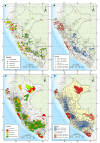[Spatial analysis of hypertension in Peruvian adults, 2022]
- PMID: 37780947
- PMCID: PMC10538923
- DOI: 10.47487/apcyccv.v4i2.296
[Spatial analysis of hypertension in Peruvian adults, 2022]
Abstract
Objectives: To perform a spatial analysis of arterial hypertension in the Peruvian adult population to identify geographic patterns with a higher concentration of cases.
Materials and methods: A spatial analysis was conducted using data from the Demographic and Family Health Survey (ENDES) 2022. A sample of 29,422 adults was included, and the global Moran's index and Getis-Ord Gi* analysis were used to evaluate spatial autocorrelation and cluster concentration.
Results: The age-standardized prevalence of arterial hypertension was 19.2%. Clusters with a high concentration of arterial hypertension were observed in departments along the Peruvian coast such as Tumbes, Piura, Lambayeque, La Libertad, Ancash, and Lima, as well as in the northern regions of the Highlands. Clusters were also found in the regions of Loreto and Madre de Dios in the Peruvian jungle.
Conclusions: This study revealed geographic patterns of arterial hypertension in Peru, with a higher concentration of cases along the Peruvian coast and in certain regions of the Highlands and Jungle. These findings highlight the need to develop strategies for the prevention and control of the disease, especially in the areas identified as high-prevalence clusters.
Objetivo.: Realizar un análisis espacial de la hipertensión arterial en la población adulta peruana, para identificar patrones geográficos con una mayor concentración de casos.
Materiales y métodos.: Se realizó un análisis espacial utilizando datos de la encuesta demográfica y de salud familiar (ENDES) 2022. Se incluyó a una muestra de 29 422 adultos y se utilizó el índice global de Moran además del análisis de puntos calientes para evaluar la autocorrelación espacial y la concentración de casos.
Resultados.: La prevalencia de hipertensión arterial estandarizada por edad fue del 19,2%. Se observaron conglomerados con una alta concentración de hipertensión arterial en departamentos de la costa peruana como Tumbes, Piura, Lambayeque, La Libertad, Ancash y Lima, así como en las regiones de la sierra norte. También se encontraron conglomerados en las regiones de Loreto y Madre de Dios en la selva peruana.
Conclusiones.: Este estudio reveló patrones geográficos de hipertensión arterial en el Perú, con una mayor concentración de casos en la costa peruana y algunas regiones de la sierra y selva. Estos hallazgos resaltan la necesidad de desarrollar estrategias de prevención y control de la enfermedad, especialmente en las áreas identificadas como conglomerados de alta prevalencia.
Keywords: Health Surveys; Hypertension; Peru; Spatial Analysis.
Conflict of interest statement
Conflictos de interés Akram Hernández Vásquez es miembro del equipo editorial de la revista. Los demás autores declaran no tener ningún conflicto de interés.
Figures

Similar articles
-
Prostate cancer mortality rates in Peru and its geographical regions.BJU Int. 2019 Apr;123(4):595-601. doi: 10.1111/bju.14578. Epub 2018 Oct 31. BJU Int. 2019. PMID: 30281883
-
Geographic differences in overweight and obesity prevalence in Peruvian children, 2010-2015.BMC Public Health. 2018 Mar 14;18(1):353. doi: 10.1186/s12889-018-5259-2. BMC Public Health. 2018. PMID: 29540170 Free PMC article.
-
Type 2 diabetes mellitus prevalence between 2005 and 2018 in population under 30 using data from the Ministry of Health of Peru.Medwave. 2019 Nov 13;19(10):e7723. doi: 10.5867/medwave.2019.10.7723. Medwave. 2019. PMID: 31887109 English, Spanish.
-
Exploring spatial autocorrelation of traffic crashes based on severity.Injury. 2017 Mar;48(3):637-647. doi: 10.1016/j.injury.2017.01.032. Epub 2017 Jan 19. Injury. 2017. PMID: 28126318 Review.
-
[Historical review of the distribution of Anopheles (Nyssorhynchus) darlingi (Diptera: Culicidae) in the Peruvian Amazon].Rev Peru Med Exp Salud Publica. 2014 Apr;31(2):310-8. Rev Peru Med Exp Salud Publica. 2014. PMID: 25123872 Review. Spanish.
Cited by
-
Socioeconomic Factors Associated with Non-Adherence to Antihypertensive Treatment Among Older Adults Affiliated to the "Pension 65" Program in Peru.Patient Prefer Adherence. 2025 Jun 12;19:1717-1729. doi: 10.2147/PPA.S523651. eCollection 2025. Patient Prefer Adherence. 2025. PMID: 40529799 Free PMC article.
References
-
- Organización Mundial de la Salud . Hipertensión [Internet] 2023. : https://www.who.int/es/news-room/fact-sheets/detail/hypertension
Publication types
LinkOut - more resources
Full Text Sources
